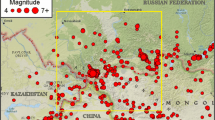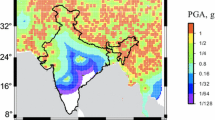Abstract
To estimate seismic hazard, the basic law of seismicity, the Gutenberg–Richter recurrence relation, is applied in a modified form involving a spatial term: \(\log N\left( {M,\;L} \right) = A - B\left( {M - 5} \right) + C\log L\), where N(M,L) is the expected annual number of earthquakes of a certain magnitude M within an area of linear size L. The parameters A, B, and C of this Unified Scaling Law for Earthquakes (USLE) in the Himalayas and surrounding regions have been studied on the basis of a variable space and time-scale approach. The observed temporal variability of the A, B, and C coefficients indicates significant changes of seismic activity at the time scales of a few decades. At global scale, the value of A ranges mainly between −1.0 and 0.5, which determines the average rate of earthquakes that accordingly differs by a factor of 30 or more. The value of B concentrates about 0.9 ranging from under 0.6 to above 1.1, while the fractal dimension of the local seismic prone setting, C, changes from 0.5 to 1.4 and larger. For Himalayan region, the values of A, B, and C have been estimated mainly ranging from −1.6 to −1.0, from 0.8 to 1.3, and from 1.0 to 1.4, respectively. We have used the deterministic approach to map the local value of the expected peak ground acceleration (PGA) from the USLE estimated maximum magnitude or, if reliable estimation was not possible, from the observed maximum magnitude during 1900–2012. In result, the seismic hazard map of the Himalayas with spatially distributed PGA was prepared. Further, an attempt is made to generate a series of the earthquake risk maps of the region based on the population density exposed to the seismic hazard.







Similar content being viewed by others
References
Auden JB (1959) Earthquakes in relation to the Damodar Valley Project. Proc Symp Earthquake Engineering, 1st University of Roorkee, Roorkee
Bak P, Christensen K, Danon L, Scanlon T (2002) Unified Scaling Law for Earthquakes. Phys Rev Lett 88:178501–178504
Bhatia SC, Chetty TRK, Filimonov M, Gorshkov A, Rantsman E, Rao MN (1992) Identification of potential areas for the occurrence of strong earthquakes in Himalayan arc region. Proc Indian Acad Sci (Earth Planet Sci) 101(4):369–385
Bhatia SC, Kumar R, Gupta HK (1999) A probabilistic seismic hazard map of India and adjoining regions. Ann Geophys 42:1153–1164
Christensen K, Danon L, Scanlon T, Bak P (2002) Unified Scaling Law for Earthquakes. Proc Natl Acad Sci 99(suppl. 1):2509–2513
Davis C, Keilis-Borok V, Kossobokov V, Soloviev A (2012) Advance prediction of the March 11, 2011 Great East Japan earthquake: a missed opportunity for disaster preparedness. Int J Disaster Risk Reduct 1:17–32. doi:10.1016/j.ijdrr.2012.03.001
Deshikachar SV (1974) A review of the tectonic and geological history of eastern India in terms of ‘plate tectonics’ theory. J Geol Soc India 15:137–149
Gansser A (1964) Geology of the Himalayas. Interscience, New York, p 289
Gansser A (1977) The great suture zone between Himalaya and Tibet: a preliminary account. In: Jest C (ed) Himalaya: Science de la Terre, Colloq. Int. CNRS, 268: 181–192
Gaur VK, Chouhan RKS (1968) Quantitative measures of seismicity applied to Indian regions. Bull Indian Soc Earthq Technol 5:63–78
Gorshkov A, Kossobokov V, Soloviev A (2003) 6. Recognition of earthquake-prone areas. In: Keilis-Borok VI, Soloviev AA (eds) nonlinear dynamics of the lithosphere and earthquake prediction. Springer, Heidelberg, pp 239–310
Gorshkov A, Parvez IA, Novikova O (2012) Recognition of earthquake-prone areas in the Himalaya: validity of the results. International J Geophys 2012, Article ID 419143, p 5. doi:10.1155/2012/419143
Gridded Population of the World, Version 3 (GPWv3) (2005) Palisades, NY: Socioeconomic Data and Applications Center (SEDAC), Columbia University. Available at http://sedac.ciesin.columbia.edu/gpw. 2012.05.29
Kaila KL, Rao M (1979) Seismic zoning maps of Indian subcontinent. Geophys Res Bull 17:293–301
Keilis-Borok VI (1990) The lithosphere of the Earth as a nonlinear system with implications for earthquake prediction. Rev Geophys 28(1):19–34
Keilis-Borok VI, Kossobokov VG, Mazhkenov SA (1989) On similarity in spatial distribution of seismicity. In: Theory and algorithms of interpretation of geophysical data. Nauka, Moscow, pp 28–40 (Computational Seismology 22, in Russian)
Khattri KN (1987) Great earthquakes, seismicity gaps and potential for earthquake disaster along the Himalaya plate boundary. Tectonophysics 138:79–92
Khattri KN, Rogers AM, Perkins DM, Algermissen ST (1984) A seismic hazard map of India and adjacent areas. Tectonophysics 108:93–134
Kossobokov VG (1984) General features of the strongest (with M ≥ 8.2) earthquake-prone areas in the non-Alpine zone of the Transasian seismic belt. In: Keilis-Borok VI, Levshin AL (eds) Logical and computational methods in seismology (Comput Seismol 17). Nauka, Moscow, pp 69–72
Kossobokov VG (2012) Earthquake prediction: 20 years of global experiment. Nat Hazards. doi:10.1007/s11069-012-0198-1
Kossobokov VG, Mazhkenov SA (1988) Spatial characteristics of similarity for earthquake sequences: fractality of seismicity. Lecture notes of the workshop on global geophysical informatics with applications to research in earthquake prediction and reduction of seismic risk (15 Nov–16 Dec., 1988), ICTP, Trieste, p 15
Kossobokov VG, Mazhkenov SA (1994) On similarity in the spatial distribution of seismicity. Computational Seismology and Geodynamics. Am. Geophys. Un., The Union, Washington, DC, 1:6–15
Kossobokov VG, Nekrasova A (2003) Generalized Gutenberg-Richter recurrence law. Geophysical research abstracts, 5, abstracts of the contributions of the EGS-AGU-EGU Joint Assembly, Nice, France, 06–11 April, 2003 (CD-ROM): EAE03- A-06597
Kossobokov VG, Nekrasova AK (2005) Temporal variations in the parameters of the Unified Scaling Law for Earthquakes in the eastern part of Honshu Island (Japan). Doklady Earth Sci 405:1352–1356
Kossobokov VG, Nekrasova A (2007) Unified scaling law for earthquakes: implications for seismic hazard and risk assessment. In: IUGG2007, July 2–13, 2007, Perugia, Italy. Abstracts, SS002–65
Kossobokov VG, Nekrasova AK (2012) Global seismic hazard assessment program maps are erroneous. Seism Instrum 48(2):162–170. doi:10.3103/S0747923912020065
Krishnan MS (1968) Geology of India and Burma. Higginbothams, Madras, p 536
Lyubushin A, Parvez IA (2010) Map of seismic hazard of India using Bayesian approach. Nat Hazards 55:543–556
Mandelbrot BB (1982) The fractal geometry of nature. Freeman, New York, p 488
Molchan G, Kronrod T, Panza GF (1997) Multi-scale seismicity model for seismic risk. Bull Seism Soc Am 87:1220–1229
Nekrasova A (2008) Unified scaling law for earthquakes: application in seismic regions worldwide. PhD Thesis, M.V. Lomonosov Moscow State University, Moscow, p 200 (in Russian)
Nekrasova AK, Kosobokov VG (2006) General law of similarity for earthquakes: evidence from the Baikal region. Doklady Earth Sci 407A(3):484–485
Nekrasova A, Kossobokov V (2002) Generalizing the Gutenberg-Richter scaling law. EOS Trans AGU 83(47), Fall Meet Suppl, abstract NG62B-0958, 2002
Nekrasova A, Kossobokov V (2003) Generalized Gutenberg-Richter recurrence law: global map of parameters. Geophysical research abstracts, 5, abstracts of the contributions of the EGS–AGU–EGU Joint Assembly, Nice, France, 6-11 April, 2003 (CD-ROM): EAE03-A-03801
Nekrasova A, Kossobokov V, Peresan A, Aoudia A, Panza GF (2011) A multiscale application of the Unified Scaling Law for Earthquakes in the Central Mediterranean area and Alpine region. Pure Appl Geophys 168:297–327
Panza G, Irikura K, Kouteva-Guentcheva M, Peresan A, Wang Z, Saragoni R (eds) (2011) Advanced seismic hazard assessment. Pure Appl Geophys 168(1–4):752
Parvez IA (2007) On the Bayesian analysis of the earthquake hazard in the north–east Indian peninsula. Nat Hazards 40:397–412
Parvez IA, Ram A (1997) Probabilistic assessment of earthquake hazards in the north–east Indian Peninsula and Hidukush region. Pure Appl Geophys 149:731–746
Parvez IA, Ram A (1999) Probabilistic assessment of earthquake hazards in the Indian subcontinent. Pure Appl Geophys 154:23–40
Parvez IA, Gusev AA, Panza GF, Petukhin AG (2001) Preliminary determination of the interdependence among strong motion amplitude, earthquake magnitude and hypocentral distance for the Himalayan region. Geophys J Int 144:577–596
Parvez IA, Vaccari F, Panza GF (2003) A deterministic seismic hazard map of India and adjacent areas. Geophys J Int 155:489–508
Turcotte DL (1997) Fractals and chaos in Geology and Geophysics, 2nd edn. Cambridge University Press, Cambridge
Turcotte DL (1999) Seismicity and self-organized criticality. Phys Earth Planet Int 111:275–294
Wadia DN (1975) Geology of India. Tata McGraw-Hill, New Delhi, p 508
Wyss M, Nekrasova A, Kossobokov V (2012) Errors in expected human losses due to incorrect seismic hazard estimates. Nat Hazards 62(3):927–935. doi:10.1007/s11069-012-0125-5
Acknowledgments
The authors acknowledge the financial support from the RFBR-DST Project “Seismic hazard and risk assessment based on pattern recognition: Himalayas and adjacent territories” (Grants RFBR No. 11-05-92691 and DST No. INT/RFBR/P-109). We also would like to thank two anonymous reviewers for their constructive suggestions and critical reviews to improve the quality of the manuscript.
Author information
Authors and Affiliations
Corresponding author
Rights and permissions
About this article
Cite this article
Parvez, I.A., Nekrasova, A. & Kossobokov, V. Estimation of seismic hazard and risks for the Himalayas and surrounding regions based on Unified Scaling Law for Earthquakes. Nat Hazards 71, 549–562 (2014). https://doi.org/10.1007/s11069-013-0926-1
Received:
Accepted:
Published:
Issue Date:
DOI: https://doi.org/10.1007/s11069-013-0926-1




